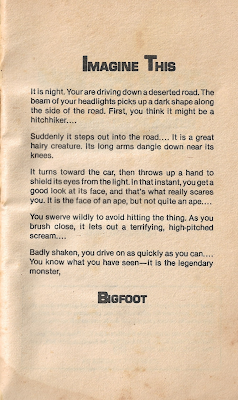Watch out! This is a Bigfoot primer for younger readers by reliable pop-sci writer Daniel Cohen which rivals "adult" titles for its measured style and broad coverage of AMERICA'S NUMBER ONE MONSTER. All the usual Bigfoot history is here, with Ape Canyon, Albert Ostman, the Patterson-Gimlin Film, Momo, the Minnesota Iceman, and so on. Cohen even mentions William Roe's sighting and includes artist Morton Kunstler's recreated drawing of the event, but leaves out any description of big Bigfoot breasts, perhaps in deference to his young audience. The Roe/PGF connection would have to wait a few more years to be made explicit ...
There's lots of maps and illustrations, including several of Momo and two different cartoons where the gag is that Bigfoot's a tiny little guy with giant feet.
Cohen does a bang up job relating recent Bigfoot sightings, including many involving UFOs and other high strangeness. The most disturbing of these concerns one Stephen Pulaski of Uniontown, PA, who witnesses some hairy beings next to a parked UFO in a field. He tries shooting them, but nothing doing, and they leave. Later, he suffers apocalyptic nightmares!
The only letdown is Chapter 10, Bigfoot History, where Cohen's normally meticulous style slips and he throws in a handful of Native American "Bigfoot" stories that really seem nothing like it - he calls the dread Wendigo a "huge creature of terrifying strength" and says it eats human flesh, but leaves out the demonic qualities and function of the cannibalism taboo entirely! One wonders how the other monsters like the Mahoni of the Yukon (not given a source), the Enemy (described by the Tlicho or Dogrib people), and the Gugwes (described by the Micmac) are being misrepresented. Cohen does accurately describe the original Sasquatch people related by J.W. Burns as being "wild Indians" as opposed to apemen.
Cohen tracks Bigfoot all over the country, and worldwide too, including those wonderful Almas who don't seem to get much press nowadays. It's an honest survey of a varied subject that normally gets a ... let's say selective presentation in many other sources. One odd detail sticks out though, when Cohen says that no one knows how the term "Abominable Snowman" came about. Real Bigfoot heads will know the popular story of newsman Henry Newman's coinage of the term, as related by Ivan T. Sanderson and others in Bigfoot literature. Was Cohen ignorant of the story or did he just not believe it?
Cohen doesn't discriminate in whether a Bigfoot sighting is proper or not, and as mentioned the freaky Hairy Bipeds of the '70s Midwest UFO waves get ample inclusion, including credit to Jerome Clark and Loren Coleman's Creatures of the Outer Edge (1978). His final chapter goes over competing theories for the monster, from simple apeman to surviving proto-human to space visitor to inter-dimensional ultraterrestrial to all out hoax. This volume would have been a good introduction to the subject for young readers back in 1982, and despite some nitpicking by your reviewer still holds interest today as a very professional presentation of a well trod subject.
An Archway Paperback Original, 1982










































